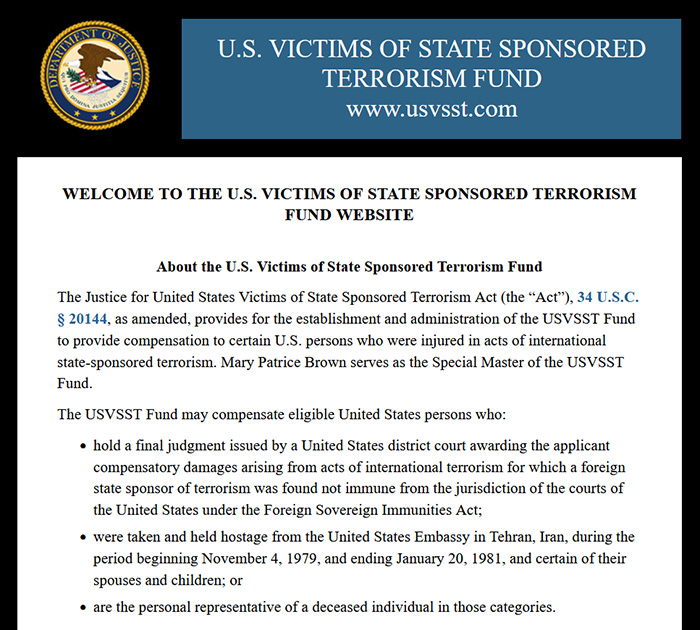The U.S. Victims of State Sponsored Terrorism Fund: What You Should Know
This fund for victims of international terrorism needs to be better known, explains an FS survivor of the East Africa bombings.
BY LEE ANN ROSS
Ripple effects from the 1998 terrorist bombing of the U.S. embassies in Kenya and Tanzania continue to this day. For many years, U.S. citizens and U.S. government non-citizen employees and contractors injured in these attacks or any other attack by state sponsors of terrorism have been eligible for victim’s compensation thanks to the 2015 act that created the U.S. Victims of State Sponsored Terrorism Fund (usvsst.com). If this is the first time you are hearing of this fund, read on to learn how it works.
Background

In 2015 Congress established the U.S. Victims of State Sponsored Terrorism (USVSST) Fund to provide compensation to U.S. citizens and U.S. non-citizen employees and contractors who were injured in acts of state sponsored terrorism. The fund awards payment to victims of acts of international terrorism based on final judgments obtained in U.S. district courts against a state sponsor of terrorism, as well as to the Americans held hostage in Tehran after the U.S. embassy was overrun in 1979.
While many of our foreign affairs colleagues qualify for access to this fund, few know about it. Unfortunately, there was no provision in the law to notify victims that the fund exists. When I called the Department of Justice (DOJ) to ask why there was no effort to notify victims of terrorism, I was told that the DOJ had done the needful by placing advertisements in U.S. newspapers announcing the fund. To my knowledge, neither the State Department nor AFSA has ever made any attempt to educate employees regarding their eligibility for this compensation.
Potential Claimants. A very large number of people who were affected have not been able to claim compensation. Potential claimants could include but would not be limited to victims of the following events: the 1983 embassy bombing in Beirut, the bombing of Marine barracks in Beirut in 1983, the Khobar Towers bombing in Saudi Arabia in 1996, the bombing of the USS Cole in Yemen in 2000, the bombings of the U.S. embassies in Kenya and Tanzania, and any victims taken hostage or murdered by a state sponsor of terrorism. The victims of the 9/11 attacks are also included in the fund and have access to half of the fund resources.
State Sponsors of Terrorism. The list of state sponsors of terrorism includes Cuba, North Korea, Iran, and Syria. Sudan recently settled a case brought by victims of the Nairobi and Dar es Salaam embassy bombings and has been removed from the list. Libya was removed in 2006.
Injuries Covered. Injury can include both physical and psychological damage. It has been ruled by the courts that when “one, who by extreme and outrageous conduct, intentionally or recklessly causes severe emotional distress to another, one is subject to liability for such emotional distress. Acts of terrorism are by their very definition extreme and outrageous and intended to cause the highest degree of emotional distress.”
In previous U.S. court cases related to the Nairobi and Dar es Salaam bombings, the court has accepted plaintiffs’ uncontroverted assertions that they did, in fact, suffer severe emotional and/or physical injury, and the court concluded that defendants were liable for intentional infliction of emotional distress (IIED). I believe that almost anyone who was in the facility or involved in helping in the immediate aftermath of the Kenya and Tanzania embassy bombings will have a strong case for an award based on IIED and/or physical injury.
Damages can include reimbursement for medical bills, economic losses, pain and suffering, solatium (compensation for emotional rather than physical or financial harm), and punitive damages. Further, it has been ruled that one did not have to be present at the site of the attack to claim IIED. Thus, one’s spouse, children, parents, and siblings can claim IIED, as well.
Amounts of the damage are set out in Peterson, et al. v. Republic of Iran (a case resulting from the bombing of the U.S. Marine barracks in Beirut in 1983). Under this, spouses can receive up to $4 million, children $2.5 million, and siblings $1.25 million. Victims’ awards are based on severity of injury. Whatever the award level is, it is highly unlikely that one will ever receive the total amount of the award because there are so many people who qualify and there is only so much money in the fund. The fund usually pays out, at most, once a year. The fund currently sunsets in 2039.
How to Make a Claim. To make a claim to the U.S. Victims of State Sponsored Terrorism Fund, one must have a final judgment from a U.S. district court. To do that, one has to sue a state sponsor of terrorism under the Foreign Sovereign Immunities Act before the 10-year statute of limitations runs out. In the case of the East Africa embassies, one sues Iran because other courts have ruled that country culpable in the bombings. And because Iran has chosen not to respond to any of the bombing cases filed against it, the judge has ruled that cases can proceed notwithstanding expiration of the statute of limitations.
I feel strongly that all of us should know about the U.S. Victims of State Sponsored Terrorism Fund, and that all who qualify should be able to access the fund. With regard to the victims of the Kenya and Tanzania bombings, I assembled a list of names for more than 200 Americans and 100 Foreign Service Nationals (now called locally employed staff) who had not yet made claims. I was unable to find contact information for everyone on the list but reached out to as many as I could.
To access the U.S. Victims of State Sponsored Terrorism Fund, you have to go through a lawyer to get the final judgment from the court. A Google search for lawyers for victims of the Kenya and Tanzania embassy bombings will bring up lawyers with the proper experience in working this kind of case.
Further Actions
My hope for the future would be that the State Department would notify any and all victims of their possible eligibility for the fund. Information regarding the fund should be included in all terrorism training programs.
I would also like to see AFSA work to amend the law so that the Justice Department is required to notify any victims of any future event of their eligibility to make a claim through the fund. An amendment should include at least the following points.
Notification. When a terrorist attack that would fall under the purview of this act occurs, the DOJ will be designated as the lead agency for the U.S. government and will make every effort to notify victims that might be eligible to make a claim to the USVSST Fund and in each case provide all of the informational material. To do that, the DOJ will undertake to reach, but not be limited to, the following:
1. U.S. government employees and contractors. The DOJ will notify employing agencies and require that said agencies notify their employees. Payroll data can be used to identify which employees would have been potential victims of said attack.
2. Private U.S. citizens. In an overseas setting, the DOJ will request that the appropriate U.S. embassy provide information to all U.S. citizens registered with the embassy.
3. Overseas schools. In an overseas setting, the DOJ will ensure that pertinent information is provided to the schools that the majority of the U.S. citizen dependents attend.
4. When an event involves U.S. service members, the DOJ will coordinate with the Department of Defense on all matters pertaining to identification and eligibility.
5. In the event of a qualifying attack on U.S. soil, the DOJ will also coordinate with local officials to notify victims. A more sweeping but obviously welcome change in the law would be for the USVSST to determine by themselves which events qualify and allow victims to apply directly to the fund without having to spend years going through the judicial process. That would also get around any statute of limitations issues.
Separately, if victims want to sue the country that sponsored the terrorism, they would still have to go through the courts.
When sharing or linking to FSJ articles online, which we welcome and encourage, please be sure to cite the magazine (The Foreign Service Journal) and the month and year of publication. Please check the permissions page for further details.
Read More...
- “Compensation Disparity Riles Victims of 1998 U.S. Embassy Bombings” by Salem Solomon, VOA, September 2020
- “Victims of U.S. Embassy terror attacks find justice, but no closure in sight” by Conor Finnegan, ABC News, November 2020
- “Justice Department Announces Total Distribution of Over $6B to Victims of State Sponsored Terrorism,” United States Department of Justice, April 2023



